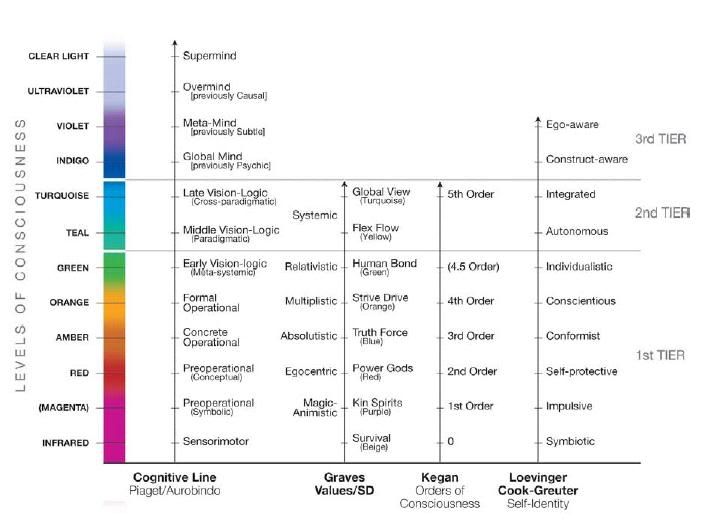 [Image stolen fron Integral Naked]
[Image stolen fron Integral Naked]I was reading an old issue of
Buddhadharma recently when I came upon an article about vipassana by
S. N. Goenka. It's not actually by him -- it's an interview with him. In it, he talks about how he teaches vipassana. One of his tenets is to accept the five precepts:
Everyone has to take five precepts: don't kill, don't steal, don't have any sexual activities, don't speak lies or harsh words, and don't take any kind of intoxicants. The precepts are not a rite or a ritual; they are part of the technique. The Buddha realized -- and a good vipassana meditator also realizes -- that when you break any of these precepts you do so only after generating an impurity in the mind. These impurities are like high waves that prevent you from going to the depth of the mind.
Okay, I understand about
Sila, and
the five precepts are the layman's version. But all the other versions I have seen refer to sexual misconduct, not to "any sexual activities." In this respect, sexuality is not prohibited:
The five precepts constitute an integrated set - each precept supports the others. To know what 'sexual misconduct' means you look at the other precepts. 'Sexual misconduct', in the spirit of the precepts as a job lot, means any sexual conduct involving violence, manipulation or deceit - conduct that therefore leads to suffering and trouble. By contrast good sexual conduct is based on loving kindness, generosity, honesty, and mental and emotional clarity - conduct that has good results. [From Buddhanet]
I don't study much Theravadin material, so my question is this: is Goenka a maverick in wanting students to abstain from all sexuality, or is this a part of the vipassana tradition that has generally been discarded in its move to the West? Is this only for the period of the training or retreat, or is it a general rule for students?
I guess it doesn't matter too much how those questions are answered. It bothers me that ALL sexual activity is seen as a defilement in his teachings. This is certainly a puritanical
Blue meme position on sexuality.
I can understand how thinking about sex can disrupt the clear mind state that vipassana aspires toward. But when one is not on the cushion or in retreat, creative, loving sexual expression is a big part of our human experience.
I guess I want an integral view here. From a
second tier perspective, we must honor the needs of each of the lower memes if we are to have an integrated being. This means we cannot deny the biological and emotional drives for sexual expression. Nor can we deny the spiritual need for union with another being through sexual expression. However, we can make every effort to filter that biology through our emotional and spiritual
lines of development.
I want an integral model for sexuality that honors the drive in humans to connect:
At the prepersonal level, that drive is for procreation and pleasure.
At the personal level, that drive is centered on bonding, expression of self, and expression of intimacy.
At the postpersonal level, that drive is expressed as transcendence of the ego or of the self in spiritual sharing with another human being, and possibly as an entry into a space where individual energies merge into an egoless "relationship" energy (this is a new thought, more to come on this later).
In an integral model, we can express all three levels at the same time, or we can choose one form of expression today and another form tomorrow. The key is to have access to all three levels of expression in as
healthy a way as humanly possible.
Certainly, sexual expression at the prepersonal and personal levels can be a defilement. Ego and base animal energy can generate unhealthy forms of sexual expression. [How and why this happens is a huge subject beyond my range of knowledge and patience to write about.]
However, postpersonal sexual expression, as long as the prepersonal and personal are healthy and in control, can be an important part of the spiritual path -- Buddhist or otherwise. This is one instance where
I might agree with Sam Harris on the need to do away with cultural baggage in Buddhism.
There is a need for Blue meme restrictions on sexual activity, but only insofar as those activities might be harmful or hurtful to others or the person engaging in them. Otherwise, we might do well to limit the influence of Blue meme beliefs on sexual expression and work toward a fully integral model that recognizes the
healthy expression of all memes.
What do you think? Please share your thoughts in the comments. I really want to open up a dialogue on this subject.
Del.Icio.Us Tags: Buddhism, Sexuality, Five precepts, Sila, Memes, Spiral Dynamics, Second tier, Prepersonal, Personal, Postpersonal, Sam HarrisTechnorati Tags: Buddhism, Sexuality, Five precepts, Sila, Memes, Spiral Dynamics, Second tier, Prepersonal, Personal, Postpersonal, Sam Harris













